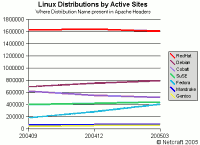It occurred to me today that if you lay out the three major players in computer operating systems and the three major players in web browsers, the results track remarkably well.
- Windows and Internet Explorer. The dominant player. Obtained that position by being good enough, cheap enough, and promoted enough to win a protracted two-way battle. Detractors claim the victory was primarily due to marketing and business practices, not quality. Plagued by a public perception of insecurity. Currently trying to maintain that lead against an opponent unlike any they’ve faced before. Believes itself to be technically superior to the other options.
- Linux and Firefox. Open source product with a core team and hundreds of volunteer contributors. Originally created as a replacement for a previous major player. Very extensible. Promoted as a more secure alternative, but has faced growing pains with its own security problems. Highly regarded among many computer power users, beginning to gain mainstream acceptance and challenging the dominant player. Believes itself to be technically superior to the other options.
- Mac OS and Opera. Has been there since the beginning. Constantly innovating, pioneering ideas that get wider exposure when their competitors adopt them. Very dedicated fan base that never seems to grow enough to challenge the dominant player. Has been declared doomed time and time again, but keeps going strong. Believes itself to be technically superior to the other options.
It breaks down, of course. Traditional UNIX is missing from the OS wars, though it provides a nice analogy to Netscape for Firefox. The battle lines don’t quite track either, since the previous wars were Windows vs. Mac and IE vs. Netscape. And Safari’s missing entirely. But it’s interesting to see the same three roles in play.
